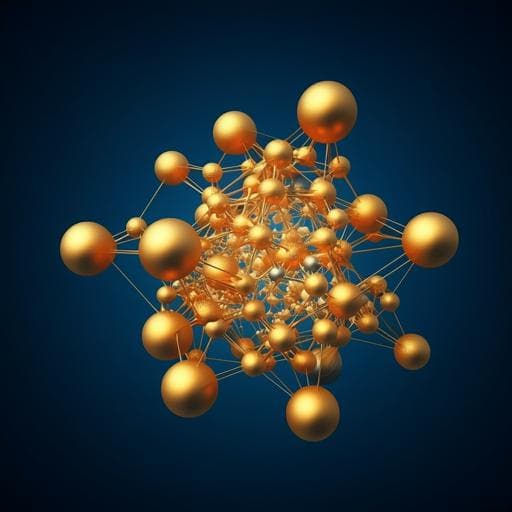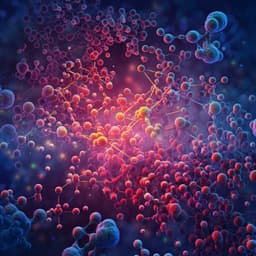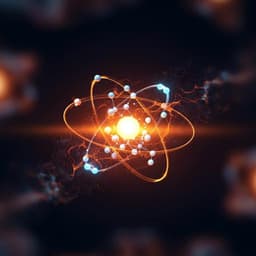
Chemistry
Single-atom tailored atomically-precise nanoclusters for enhanced electrochemical reduction of CO₂-to-CO activity
Y. Wang, F. Yan, et al.
Discover how the innovative co-electropolymerization strategy led by Yi-Man Wang, Fang-Qin Yan, Qian-You Wang, Chen-Xia Du, Li-Ya Wang, Bo Li, Shan Wang, and Shuang-Quan Zang resulted in Au8 nanoclusters with extraordinary CO2 reduction capabilities, showcasing an astonishing ~18.07 fold increase in activity compared to isolated clusters, all while enhancing stability through single-atom functionalization.
~3 min • Beginner • English
Introduction
Catalysis with well-defined metal nanoclusters (NCs), which bridge small-molecule and heterogeneous metal catalysis, has attracted significant attention but suffers from poor stability and catalytic properties that hinder practical use. Prior attempts to improve intrinsic catalytic properties have focused on composition and structural tailoring, including heterometallic doping, ligand engineering, and size regulation, yet controllable synthesis of well-defined target NCs remains challenging due to their sensitivity during assembly. Single-atom (SA) catalysts have emerged as efficient catalysts, and integrating SAs with metal NCs has been shown to induce asymmetric electron distribution and modulate intermediate adsorption free energies, thereby enhancing activity via synergistic effects. However, most NC–SA catalysts are prepared by pyrolysis, producing ill-defined structures that complicate structure–activity correlation. This study aims to develop a controllable, well-defined strategy to functionalize atomically precise Au nanoclusters with isolated SAs to improve both activity and stability for electrochemical CO₂-to-CO conversion.
Literature Review
The literature highlights multiple strategies for tuning metal nanocluster catalysis: (i) heterometallic doping to modify active sites and electronic structures; (ii) ligand engineering to balance stability and activity; and (iii) precise size control to influence catalytic behavior. Despite many reports, achieving atomically precise and structurally well-defined catalysts is difficult because clusters are susceptible to external stimuli during synthesis. Recent advances integrating single atoms with clusters demonstrate that SAs can redistribute charge and tune adsorption energetics of intermediates, improving catalytic performance. Nevertheless, prevalent pyrolysis-based fabrication yields vague structures, limiting mechanistic insight. Therefore, a need persists for a methodology that assembles well-dispersed, atomically precise NCs together with isolated SAs in a controlled framework to elucidate and exploit NC–SA synergy.
Methodology
- Synthesis of ligands and Au8 nanoclusters: The alkynyl carbazole ligand HCzPA (9-(4-ethynylphenyl)carbazole) was synthesized per prior reports. Au8 clusters [Au8(dppp)4(CzPA)2]2+ were prepared from [Au8(dppp)4](NO3)2 by reacting with HCzPA and sodium methoxide in methanol, followed by extraction and crystallization (SCXRD confirmed structure; PXRD verified phase purity). DCP (3,8-di(9H-carbazol-9-yl)-1,10-phenanthroline) was synthesized and chelated with metal salts to give DCP@M (M = Fe, Co, Ni, Cu, Zn).
- Co-electropolymerization: Au8 crystals and DCP@M were co-electropolymerized in CH3CN/CH2Cl2 (2/1 v/v) with 0.1 M LiClO4 via cyclic voltammetry between 0–2 V (vs. Ag/AgCl) at 100 mV s−1 for 20 cycles on carbon paper or ITO, producing Poly-(Au8-DCP@M). Controls included Poly-(Au8-DCP) (Au8 + DCP), Poly-Au8 (self-polymerized Au8), and Poly-DCP@M (self-polymerized DCP@M).
- Structural characterization: TEM and HAADF-STEM identified uniformly dispersed Au nanoclusters (~1.0 nm) and atomically dispersed Fe SAs in Poly-(Au8-DCP@Fe); STEM-EDS mapping confirmed homogeneous Fe, Au, P, N distributions. ICP-OES quantified metal loadings (e.g., Au 5.99 wt%, Fe 4.00 wt% in Poly-(Au8-DCP@Fe)). XANES/EXAFS (Au L3-edge, Fe K-edge) and WT-EXAFS established preserved Au–C, Au–P, Au–Au coordination and Fe–N coordination without Fe–Fe bonds; Au exhibited slightly higher oxidation state upon Fe SA introduction. XPS showed Au 4f7/2 positive shifts and Fe 2p negative shifts, indicating electron transfer from Au clusters to ligands/Fe sites. CO-DRIFTS tracked adsorbed CO shifts, reflecting electron density changes at Au and Fe sites.
- Electrochemical CO₂RR testing: Conducted in a three-electrode H-cell (0.5 M KHCO3, pH 7.3), with Ag/AgCl reference and Pt counter. Gas products analyzed by GC; liquids by 1H NMR. Faradaic efficiency (FE) was computed from product-specific currents and total current. LSV and Tafel analyses assessed activity and kinetics; double-layer capacitance (Cdl) from CV estimated ECSA. Chronoamperometry at fixed potential evaluated stability. Isotopic labeling with 13CO2 verified product origin.
- In situ/operando spectroscopy: ATR-FTIR under CO₂RR potentials monitored intermediates (*COOH, *COb, *COl). CO-DRIFTS probed adsorption on Au and Fe sites.
- Theory: DFT calculations modeled charge density differences, Bader charges, PDOS (d-band center), free energy profiles for CO₂RR and HER on Au cluster sites within Poly-Au, Poly-(Au-DCP), and Poly-(Au-DCP@Fe), and on isolated Fe SA sites. Electrostatic potential analysis examined CO₂ enrichment near ligand environments; preferred *COOH adsorption site on Au atom identified.
Key Findings
- A co-electropolymerization strategy produced hybrid catalysts Poly-(Au8-DCP@M) with well-dispersed Au nanoclusters and isolated M single atoms (M = Fe, Co, Ni, Cu, Zn) entrapped in a poly-carbazole matrix.
- Electronic modulation by Fe SAs increased the oxidation state of Au sites (XPS Au 4f7/2 upshift; CO-DRIFTS red-shift of Au–CO), decreased Fe valence (Fe 2p downshift), and induced charge redistribution (Bader charge change; PDOS d-band center of Poly-(Au-DCP@Fe) at −3.39 eV vs −4.19 eV for Au crystal, −4.44 eV Poly-Au, −3.85 eV Poly-(Au-DCP)).
- Activity/selectivity: Among Poly-(Au-DCP@M), maximum CO FE values were 90.89% (Fe, −0.57 V), 87.23% (Co, −0.67 V), 74.14% (Ni, −0.57 V), 50.01% (Cu, −0.47 V), 9.25% (Zn, −0.57 V), with Fe delivering the best performance. At −0.57 V, CO FE: Poly-(Au-DCP@Fe) 90.89% > Poly-(Au-DCP) 69.06% > Poly-Au 12.56% > Poly-DCP@Fe 1.16% > Au crystal 0.60%.
- Intrinsic activity/kinetics: Despite similar ECSA (Cdl: Poly-(Au-DCP@Fe) 0.275 mF cm−2; Poly-(Au-DCP) 0.271 mF cm−2), Poly-(Au-DCP@Fe) showed much higher current density and more positive onset potential. Tafel slopes: 218 mV dec−1 (Poly-(Au-DCP@Fe)) < 237 (Poly-(Au-DCP)) < 240 (Poly-Au) < 381 (Au crystal), indicating faster CO₂RR kinetics.
- Stability: At −0.57 V, CO FE remained above 80% over 6 h with stable current; minor degradation attributed to limited growth of larger Au clusters. Post-reaction HAADF-STEM and XPS confirmed structural/electronic stability.
- Mechanism/intermediates: In situ ATR-FTIR detected stronger *COOH and *CO signals on Poly-(Au-DCP@Fe) vs controls; linear *CO on Fe SAs and bridge *CO on Au were observed. DFT free energy barrier (ΔG) for CO₂→*COOH decreased from 1.81 eV (Au) to 1.38 eV (Poly-Au) to 1.12 eV (Poly-(Au-DCP)) to 0.81 eV (Poly-(Au-DCP@Fe)), rationalizing enhanced activity and selectivity; HER barriers increased on Poly-(Au-DCP@Fe). Selectivity metric U_L(CO₂)−U_L(H₂) was most positive (0.39 eV) for Poly-(Au-DCP@Fe). Isotope labeling (m/z 29 for 13CO) confirmed CO originates from CO₂.
- Overall, functionalizing Au8 nanoclusters with Fe SAs amplified CO₂-to-CO activity by ~18.07-fold relative to isolated Au8 clusters, by strengthening *COOH adsorption and promoting a favorable CO₂RR pathway while suppressing HER; the polymer network mitigated agglomeration.
Discussion
The study addresses the challenge of improving the intrinsic activity and stability of atomically precise nanoclusters by integrating isolated single-atom sites through co-electropolymerization. Experimental spectroscopy (XPS, XANES/EXAFS, CO-DRIFTS, ATR-FTIR) and DFT consistently show that Fe SAs modulate the electronic structure of Au nanoclusters, shifting the d-band center closer to the Fermi level, redistributing charge, and enhancing binding of the key *COOH intermediate in the rate-determining step. These changes lower the thermodynamic barrier for CO₂ activation and concurrently increase the barrier for the competing HER, yielding higher CO selectivity and activity. Control experiments demonstrate that Au nanoclusters, not Fe SAs, serve as the main CO₂RR active sites; Fe SAs primarily act as electronic modulators. The cross-linked polymer matrix secures both clusters and SAs, maintaining dispersion and mitigating agglomeration, thereby sustaining performance during operation. The approach generalizes across different single-atom species (Co, Ni, Cu, Zn) with trends consistent with Fe, underscoring the broader relevance of SA-induced electronic tuning of nanoclusters for CO₂-to-CO catalysis.
Conclusion
This work presents a co-electropolymerization strategy to construct well-defined nanocluster–single-atom hybrid catalysts, exemplified by Poly-(Au8-DCP@Fe), which deliver high CO₂-to-CO performance (maximum CO FE 90.89% at −0.57 V) and improved kinetics and stability compared to isolated components. Mechanistic studies reveal that isolated Fe single atoms positively regulate the electronic structure of Au nanoclusters, strengthening *COOH adsorption and favoring the CO₂RR pathway while suppressing HER. The polymer scaffold uniformly disperses and stabilizes both clusters and SAs, reducing deactivation from agglomeration. These findings establish single-atom functionalization as an effective route to enhance the inherent catalytic properties of atomically precise metal nanoclusters.
Limitations
- Durability tests were limited to 6 h; slight CO FE decay was attributed to the formation of some larger Au clusters during prolonged operation.
- Performance and selectivity were evaluated in 0.5 M KHCO3 in an H-cell; behavior in other electrolytes, pH, or device configurations was not examined here.
- Control experiments indicate Fe single-atom sites alone are inactive for CO formation under these conditions; thus, the approach relies on cluster sites as active centers with SAs as electronic modulators.
Related Publications
Explore these studies to deepen your understanding of the subject.







